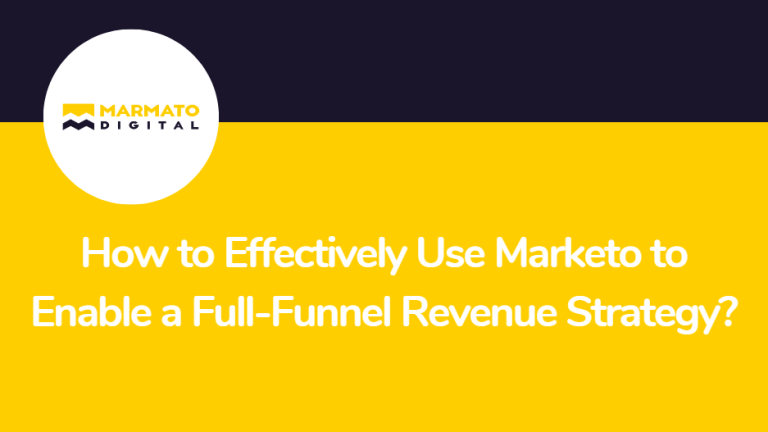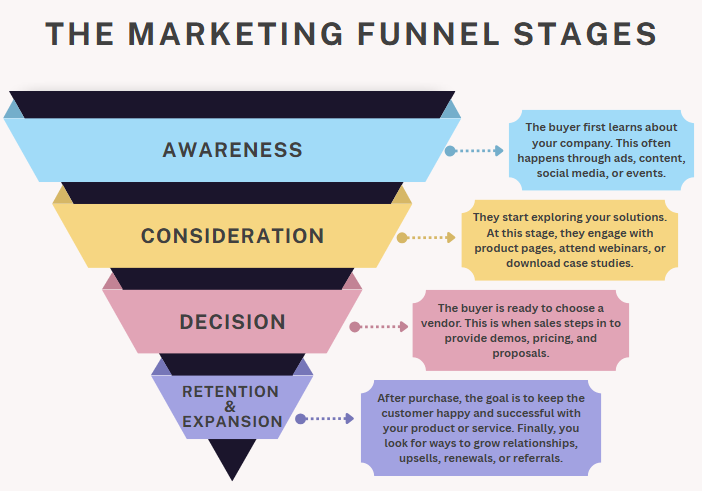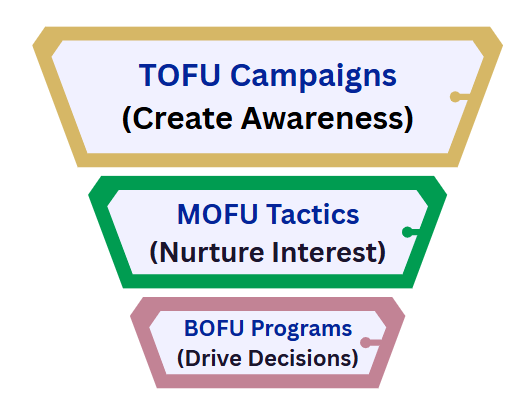In today’s competitive market, growing revenue isn’t just about generating leads, it’s about guiding buyers through every step of their journey, from first touch to loyal customer. That’s when a full-funnel revenue strategy steps in. It means marketing, sales, and customer success teams work together to engage prospects at all funnel stages.
Generally, these teams often work in silos, data lives in different systems, and it’s tough to get a clear view of what’s driving pipeline and revenue. Without the right tools and processes, it becomes nearly impossible to track how marketing efforts contribute to business growth at each stage. That’s where Marketo can make a big difference. It gives visibility and control to align teams and build a strategy that supports every part of the funnel.

Understanding the Full Funnel Revenue Strategy:
You must think beyond lead generation to drive predictable and scalable growth. That means focusing on the entire customer funnel, not just the top. A full-funnel approach looks at how buyers move from first learning about your brand to becoming repeat customers and advocates.
Here’s a quick breakdown of the typical funnel stages:

Each of these stages plays a role in driving revenue. Focusing only on top-of-funnel leads won’t deliver the results you need. Success comes from building a connected experience across all stages, with smooth handoffs between marketing, sales, and customer teams.
This is why alignment is critical. Marketing creates demand and nurtures interest. Sales converts interest into deals. Customer success drives satisfaction and loyalty. When these teams use the same strategy, data, and tools like Marketo, they can move buyers through the funnel more efficiently and grow revenue faster.
Mapping the Full Funnel Revenue Strategy in Marketo:
Once you understand the full funnel, the next step is to build it inside Marketo. This means organizing your campaigns and programs in a way that matches each stage of the customer journey, so you can track, manage, and optimize performance at every step.
- Structure Your Programs by Funnel Stage:
In Marketo, every campaign should have a clear goal linked to a funnel stage:
- Awareness: Run programs like email blasts, social media promotions, and content downloads to drive initial interest.
- Consideration: Set up nurture programs with educational content, webinar invites, or product comparisons.
- Decision: Create campaigns to push buyers toward action, like demo requests, trial sign-ups, or sales follow-ups.
- Retention & Expansion: Use engagement programs for onboarding, customer education, and upsell offers.
By organizing your programs this way, it becomes easier to measure what’s working and see how leads are moving through the funnel.
- Use Lead Lifecycle and Program Statuses Wisely:
Marketo’s lead lifecycle model is your foundation for tracking funnel movement. Use clear lifecycle statuses like:
- MQL (Marketing Qualified Lead)
- SAL (Sales Accepted Lead)
- SQL (Sales Qualified Lead)
- Opportunity
- Customer
Pair these with program statuses to show engagement, like “Registered,” “Attended,” or “Engaged.” This helps you understand not only where someone is in the funnel, but how they’re interacting with your campaigns.
- Follow a Clear Tagging and Naming System:
Clean naming and tagging make a huge difference in visibility and reporting. Here are a few simple tips:
- Start program names with funnel stage and region (e.g., “TOFU_NA_Webinar_2025Q2”).
- Tag programs by campaign type, product line, or target audience.
- Keep a naming convention document so your whole team stays consistent.
This structure helps you slice data any way you need by stage, region, buyer type, or product, and keeps your instance scalable as your business grows.
Using Lead Scoring and Lifecycle Models to Drive Funnel Movement:
To move leads through the funnel efficiently, you need a clear way to tell who’s ready for sales and who still needs nurturing. That’s where lead scoring and lifecycle models in Marketo come in. Together, they help you prioritize the right prospects and ensure smooth handoffs between marketing and sales.
- Lead Scoring – Identify High-Intent Prospects:
Marketo lets you assign scores based on what people do and who they are. For example:
- Behavioral scores: Actions like email clicks, website visits, webinar attendance, or content downloads.
- Demographic/firmographic scores: Job title, company size, industry, or location.
When a lead’s score crosses a certain threshold, it signals they’re likely ready to talk to sales. This helps your team focus on high-intent prospects, not just anyone who filled out a form.
- Lifecycle Models – Track Funnel Progress:
Marketo’s Revenue Cycle Modeler helps you define and track each stage in your lead lifecycle, like MQL, SAL, SQL, Opportunity, and Customer. It automates how leads move from one stage to the next based on their actions or scores.
This gives you a real-time view of how many leads are at each stage, where they might be stuck, and how fast they’re moving through the funnel. It’s a powerful way to spot bottlenecks and improve performance.
- Align Scoring and Lifecycle for Timely Sales Handoffs:
Lead scoring and lifecycle stages should work together. When a lead’s score hits the MQL threshold, Marketo can automatically change their lifecycle stage and alert sales through your CRM. This creates a consistent process and ensures no hot leads fall through the cracks.
Aligning Campaigns to Funnel Goals:
To get the most value out of your marketing programs, every campaign in Marketo should serve a specific purpose based on where the prospect is in the funnel. This helps drive the right actions, whether it’s building awareness, nurturing interest, or closing deals.

Top-of-Funnel (TOFU) Campaigns: Create Awareness
At the top of the funnel, the goal is to attract new leads and build brand awareness. These people may not know much about your company yet. So, these campaigns should be light on product details and focused on solving a problem or offering value.
Common TOFU campaign examples:
- Content offers like ebooks, blog articles, or checklists
- Webinars that educate on industry trends or common challenges
- Social media campaigns or paid ads that link to lead capture forms
Mid-Funnel (MOFU) Tactics: Nurture Interest
In the middle of the funnel, leads are exploring solutions. They’ve engaged with your brand and are starting to consider your product. The goal here is to educate, build trust, and show how your product solves their specific problems.
Effective MOFU tactics include:
- Nurture tracks with targeted emails based on past behavior
- Case studies or customer success stories
- Comparison guides or product-focused webinars
Bottom-of-Funnel (BOFU) Programs: Drive Decisions
At the bottom of the funnel, leads are ready to talk to sales or decide. Your campaigns should be personalized and focused on ROI, use cases, or solving final objections.
Strong BOFU examples:
- Demo requests or free trials
- One-to-one emails from sales reps
- Account-Based Marketing (ABM) programs targeting specific high-value accounts
Measuring Funnel Performance in Marketo:
To improve your funnel, you need to measure it. Marketo gives you powerful tools to track how leads move across stages, so you can see what’s working and what’s not. When paired with your CRM, it provides a complete view of marketing’s impact on pipeline and revenue.
- Track Funnel Conversion Rates with Reports and Dashboards
Marketo’s analytics features let you build dashboards that show key metrics across each funnel stage. You can track:
- How many leads are entering the funnel
- How long do they stay in each stage
- How many are converting from MQL to SQL to Closed Won
With Program Performance Reports, you can also see which campaigns are driving the most engagement and moving leads forward.
- Connect Marketo with Your CRM for Closed-Loop Reporting
To get the full picture, you need to link Marketo with your CRM, like Salesforce. This allows you to:
- Sync lead and opportunity data between systems
- See how marketing campaigns influence pipeline and revenue
- Attribute revenue back to specific programs or touchpoints
- Key Metrics Revenue Ops Leaders Should Monitor
To manage the funnel effectively, here are a few must-track metrics:
- MQL to SQL Conversion Rate: How many qualified leads are accepted by sales?
- Pipeline Velocity: How fast are leads moving through the funnel?
- Lead Source Performance: Which channels or campaigns generate the best leads?
- Cost per Opportunity: How much are you spending to generate pipeline?
These insights help you make smarter decisions, align marketing and sales efforts, and continually improve your revenue engine.
Conclusion:
A full-funnel revenue strategy only works when every stage of the customer journey is aligned, and Marketo is built to support that alignment. With smart lifecycle management, effective lead scoring, and clear reporting tools, Marketo helps you move the right leads forward and measure what drives revenue.
You don’t need to overhaul everything at once. Start small. Choose one funnel stage, such as improving MQL to SQL handoffs, and utilize Marketo tools to optimize that specific piece. Then expand from there with clear use cases and simple process improvements.
When used well, Marketo becomes more than a marketing tool, it becomes a key driver of revenue growth across the entire funnel.
Ready to put your full-funnel strategy into action with Marketo?
Subscribe to Newsletter
Get our latest blogs directly to your inbox.

